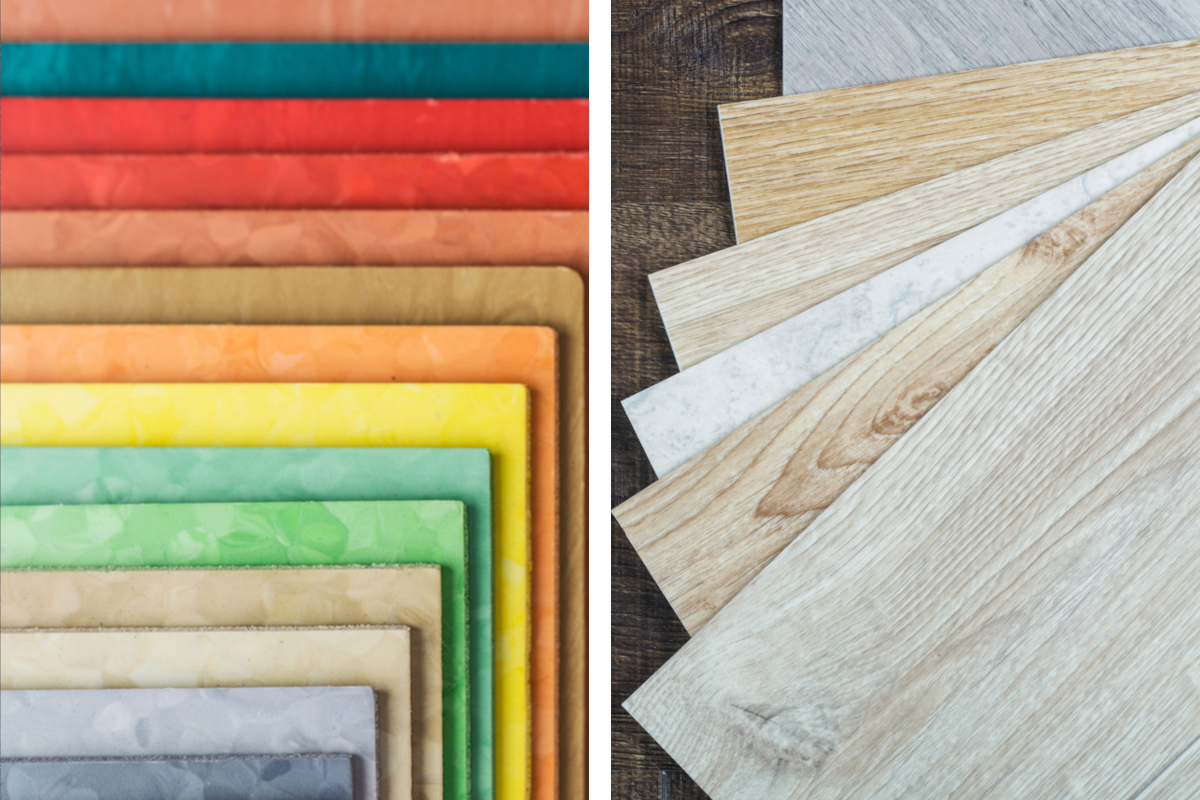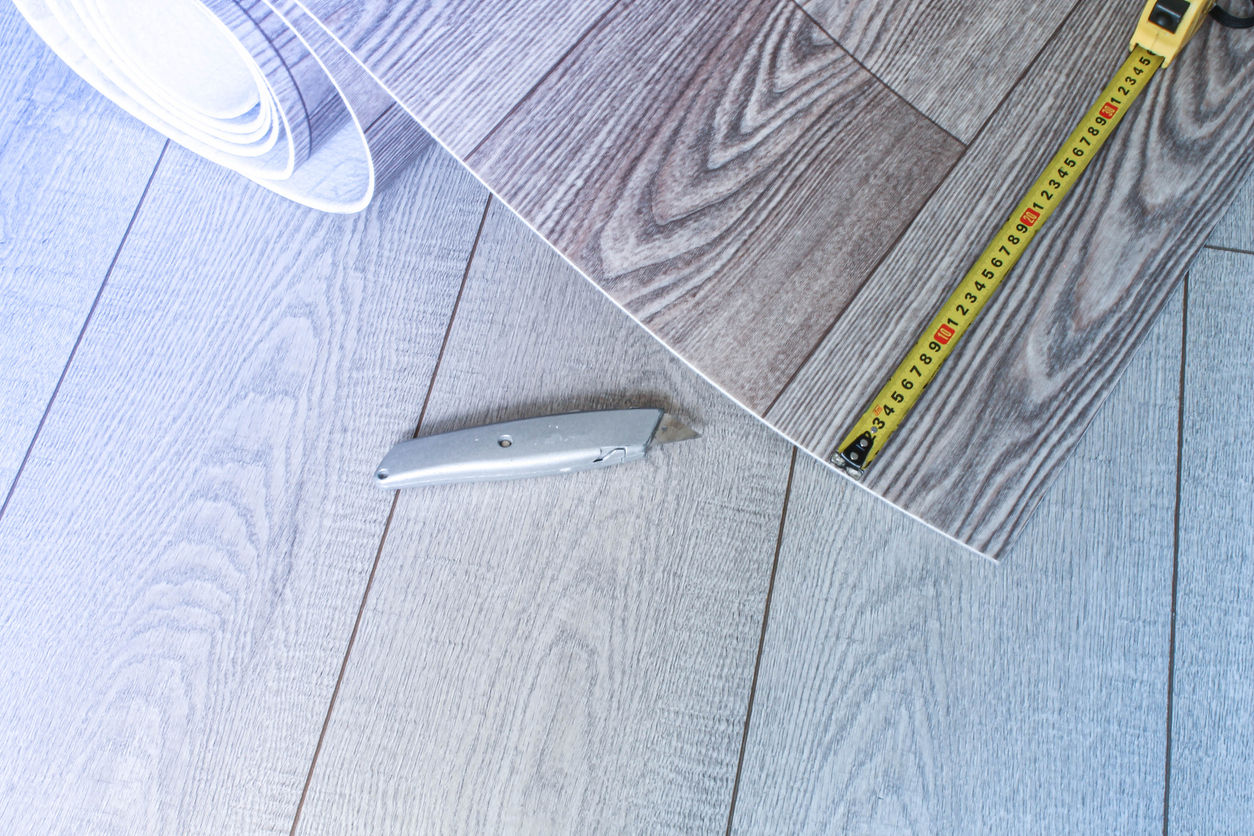

We may earn revenue from the products available on this page and participate in affiliate programs. Learn More ›
Linoleum and vinyl are both popular flooring options for kitchens and bathrooms because they’re durable, water-resistant, and easy to clean. Each of these materials are relatively inexpensive when compared with tile or hardwood. Because both are sold in sheet form, they’re often confused for one another. However, there are some major differences between vinyl and linoleum.
We’ve compared linoleum vs. vinyl flooring below, explaining how these two flooring options are made and breaking down their pros and cons in terms of sustainability, aesthetics, and maintenance.
RELATED: Flooring Installation Costs: A Homeowner Budget Guide
Linoleum flooring is made of natural materials, while vinyl is synthetic and environmentally harmful.

The main difference between vinyl and linoleum flooring is that vinyl is manufactured from synthetic materials, while linoleum contains natural materials.
Linoleum flooring was invented in the 1860s by Frederick Walton as an alternative to traditional wood planks. Linoleum is made from ingredients like linseed oil, sawdust, cork dust, resin, limestone, and mineral filling agents and pigments. It’s relatively eco-friendly because it doesn’t contain any volatile organic compounds (VOCs). While linoleum at one time included asbestos, that hasn’t been the case since the 1970s.
Vinyl flooring is made from plastic—specifically polyvinyl chloride (PVC), a petrochemical resin that emits toxic phthalates when burned. Phthalates are associated with cancer risk in humans and have been banned from children’s toys in California and the European Union. The manufacture of vinyl requires a large amount of petroleum, making it an environmentally harmful practice.
Vinyl flooring comes in a wider variety of colors, patterns, and textures than linoleum.
Both linoleum and vinyl flooring come in a variety of colors, but vinyl floors’ synthetic materials can be crafted into virtually any shape or color. As a result, vinyl floors can be made to mimic the look of wood, stone, tile, or other natural materials. Vinyl flooring is made up of multiple layers of material, including a core layer printed with a color or pattern and a protective clear layer on top. However, the appearance of a vinyl floor can become worn or discolored if the top layer wears down.
A linoleum floor, on the other hand, is made up of a single layer, which will retain its color longer if properly maintained. However, being made of natural materials, linoleum flooring rolls come in a more limited variety of finishes and patterns than vinyl.
Linoleum requires occasional sealing, whereas vinyl is waterproof.

One of vinyl flooring’s primary advantages is that it’s completely waterproof and won’t be damaged by spills. This makes vinyl an excellent choice for use in bathrooms and kitchens. When shopping for the best waterproof option, consider sheet vinyl over vinyl tiling because it has fewer seams and will therefore be even more moisture-resistant.
Linoleum is water-resistant, but it can be damaged by significant water exposure. It needs to be sealed regularly—every 3 to 10 years, depending on the level of foot traffic—in order to maintain its water resistance.
RELATED: The Best Vinyl Plank Flooring for Your Home
Vinyl and linoleum floors are both easy to clean.
Vinyl and linoleum can both be swept, mopped, and vacuumed without incurring damage, making each option easy to clean. Vinyl has a slight edge because it can be cleaned with virtually any kind of detergent or cleaning product without worrying about causing discoloration. Vinyl’s waterproof nature also means it’s resistant to the buildup of mold and mildew. When cleaning linoleum, on the other hand, it’s best to use a gentle cleaning product or a dedicated solution specifically designed for linoleum floors.
Linoleum is more durable than vinyl flooring.

Both linoleum and vinyl are each highly durable flooring options. When comparing the two materials in terms of durability, however, linoleum has the advantage. The top layer of vinyl can wear away over time, whereas linoleum’s single layer is longer-lasting. Linoleum also offers increased heat resistance in comparison with vinyl. When exposed to high heat, vinyl can melt and emit potentially toxic chemicals. However, linoleum does have to be sealed periodically, which means that some maintenance is necessary, whereas a vinyl floor never needs to be sealed.
Vinyl sheet flooring installation is more DIY-friendly than linoleum sheet flooring installation.
One reason that linoleum and vinyl flooring are often viewed as interchangeable is that they are both sold in sheet form. Additionally, they’re both thin and must be installed on a smooth, even underlayer. Both materials can be tricky to install when working with full sheets, but vinyl sheet flooring is slightly easier to work with than linoleum sheet flooring because of its greater flexibility. For even easier installation, vinyl is also sold as peel-and-stick tiles with adhesive backings. While linoleum is also available in tiles and planks, linoleum tiles tend to require click-and-lock installation and aren’t quite as straightforward to work with as vinyl tiles and planks.
Vinyl flooring costs less than linoleum, but linoleum lasts longer.

Cost is typically the primary consideration when choosing the best flooring option. In terms of the relative cost of vinyl vs. linoleum flooring, vinyl is the more affordable option. Sheet vinyl ranges from 50 cents to $2 per square foot, while vinyl tiles are a bit pricier at $3.50 per square foot. Sheet linoleum, on the other hand, costs between $5 and $7 per square foot. Linoleum tiles tend to cost between $3 and $5 per square foot. The higher cost of linoleum may be worthwhile, however, because its lifespan is about twice that of vinyl. Linoleum lasts an average of 20 to 40 years, whereas vinyl lasts only between 10 and 20 years.
RELATED: How to Remove Linoleum Flooring
